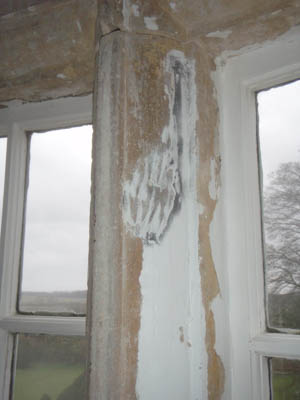Bristle Blasting - the hand tool that behaves like a grit blaster
Removing paint from stone with a bristle blaster

One of the challenges we have faced over the years is to find a technique to safely remove the 'stubborn' patches of paint or dirt from a surface after we have used pressure washing, chemical stripping, sand jetting or even dry ice blasting. In 2013 we discovered that a hand tool we have had in our possession for a number of years - bought to clean up rust and 'missed bits' on blast cleaned metal (it is sold as a paint shop surface preparation tool) can be used on stone and brick as well. It has the advantage that the cleaning face is much smaller than with a sand jet, and can therefore be much more controlled. But the process is very like a hand held continuous belt grit blast - the teeth on the wheel act like particules of gri abd bristle blaster tool behaves like a sandblaster. It is however, still important to know when to stop!
Bristle blasting paint from a previously chemically stripped sandstone pillar, May 2013

bristle blasting of the pillars - before (above) and after (below) even with this technique we couldn't get all the paint off - but the sandstone was too soft to risk any other kind of blasting; in this case the paint had been previously softened with the chemical stripper.
In the photographs below, we followed up dry ice blasting of paintwork from stone in a Listed Grade I property in East Yorkshire with the bristle blaster to try to get some of the lime based filler out of the stonework. - Lime based fillers and paints are always very difficult to remove with chemical strippers


Key Benefits
- Flexible, many surfaces and contaminants can be dealt with quickly and easily.
- Very localised blast area (which also does mean that it is a slow process)
- lower mess than abrasive blasting, so it can be used indoors.
- Suitable surface profile generation for subsequent treatments, such as Zinga cold galvanising.
- Longer time-scales before flash rusting appears